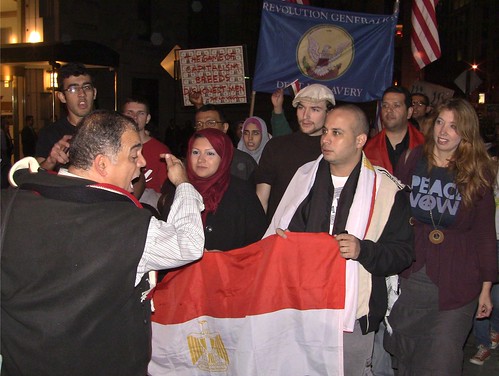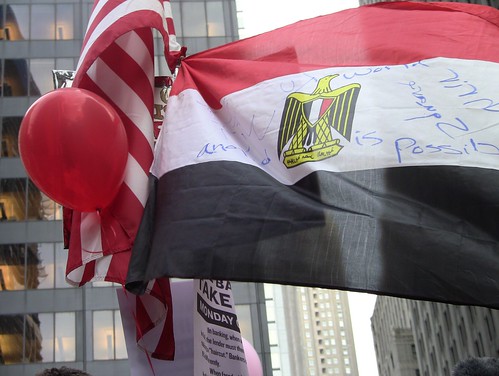October 25, 2011
Two Egyptian activists led hundreds of American protesters on a march out of Zuccotti Park on Monday, walking past the police barricades on Wall Street for the first time since protests began about six weeks ago. It marked a peculiar show of solidarity between a movement born out of decades of oppression and a movement still struggling to gain traction in a country where citizens are free to organize, speak out and vote.
“It is very important that we support you and you support us at all times,” Ahmed Maher, a leading member of the 6th of April Youth Movement, which was credited for organizing the initial protest that unleashed the Egyptian revolution, told dozens of protesters who gathered before the march to hear him speak.
A shared desire for change, he emphasized, had offset differences in place and circumstance and galvanized masses of disenfranchised citizens from the Middle East to Europe to America. The contagion marks a rare moment of global coalescence, which appears to be taking root spontaneously. This is partly true, but the striking speed at which the protests spread, their likeness in form and organizational tactics was underpinned by the deliberate work and planning of tech-savvy youth-led groups. Disparate political activists, who for years had been taking part in scattered marches, are now pooling tools and ideas over social networks and pushing forward their varying demands in a more effective and cohesive manner.
From the very beginning, the connection between Occupy Wall Street and the Arab Spring was made clear.
“Are you ready for a Tahrir moment?” asked a poster that appeared on July 13 in Adbusters, a Vancouver-based anti-corporate magazine not linked to any specific grassroots movement. “On Sept 17, flood into lower Manhattan, set up tents, kitchens, peaceful barricades and occupy Wall Street,” it instructed. The invitation was repeated through Facebook and Twitter and on the set date, hundreds of protesters, mostly in their 20s, started an indefinite sit-in at Zuccotti Park.
The result of this arbitrary moment was the culmination of months of concerted planning with more than just a symbolic connection between young protesters in downtown Manhattan and their counterparts in downtown Cairo. Monday was not the first time they met.
Marissa Holmes, a 25-year-old integrated media graduate student at Hunter College, had been involved since 2006 in building what she describes as a “horizontal broad-based youth movement” in the United States. In April, well before the Adbuster campaign, Ms. Holmes reached out to Mr. Maher and Waleed Rashed, another member of the 6th of April movement, in Egypt. Coincidently, Mr. Maher and Mr. Rashed were due in New York the same month to speak at an event organized by Egyptian-Americans. They agreed to meet with the group of American activists who were eager to soak in their experience.
“I just Facebooked them, it was really that simple,” Ms. Holmes recalls.
On April 26, a group of about 30 activists met at The Brecht Forum in downtown Manhattan with Mr. Maher and Mr. Rashed, both of whom spoke little English but were still able to convey a strong motivational message to their American counterparts.
“I was very heartened to hear from them because at the time we were trying to make things happen and no one was listening,” said Jesse Myerson, 25, who attended the meeting and wrote about it the next day on a grassroots website, The Busy Signal (http://tiny.cc/oxcon). “They pointed out that their success was the result of years of organizing and that eventually a spark happens that blows the powder keg, but in order for that to happen, there has to be a powder keg.”
Mr. Myerson, who was sitting in the media corner of Zuccotti Park, was momentarily interrupted by Jeff Smith, another protester who held out a book in his hand. It was titled Tweets from Tahrir.
The late April meeting was followed with a month-long trip that Ms. Holmes made to Egypt in May. In a parallel effort, two of her colleagues flew to Spain to observe protesters in Madrid. Ms. Holmes spent her time with Mr. Maher and Mr. Rashed as well as other youth group organizers, mostly trying to trace their evolution and taking note of how they organized themselves through a decentralized structure across various cities. More than anything, she was keenly interested in learning how they employ social media in disseminating information and rallying protesters. Ms. Holmes realized that differences far outweighed similarities when it came to the political systems, social make-up and general grievances among people in Egypt and the United States. Still, she sought inspiration from those like Mr. Maher and Mr. Rashed – and found a common ground.
“I am not saying we are the same, but we have to overcome the areas where we think we are oppressed, and that’s a common struggle” Ms. Marissa said, contrasting the climate of endemic repression and police torture that protesters in Egypt faced to the institution-based political framework that governs life in the United States.
“What is this? No rocks, no thugs, nothing?” Mr. Maher jokingly said on Monday as he marched through Manhattan’s financial district with minimal police obstruction.
Unlike the 18-day uprising in Tahrir Square, which forced out Egypt’s president, Occupy Wall Street protesters have been unable to translate abstract notions of social injustice and corporate greed into obvious culprits or a concrete set of political demands. Their failure to send a unified message over the past six weeks has raised skepticism that the movement will impress radical change.
“It’s not like Egypt,” said Steven Brams, professor of politics at New York University. “I don’t see any issue kindling this current protest movement, it’s quite symbolic and there is no overriding cause. It’s not happening and it’s not going to happen.” Instead, Mr. Brams describes the less defined Wall Street movement as the result of a number of frustrations stemming from unemployment and a general disappointment in the Obama administration, which, he argues, will subside through the coming election.
Still, protesters continue to show resolve and resilience. When the police threatened to evict them from Zuccotti Park less than two weeks ago, thousands came out to push back. They rallied themselves with drumbeats and vowed not to surrender a territorial hold, which in their eyes had become largely symbolic for re-appropriating their country to themselves. In the meantime, Ms. Holmes and other leading organizers in the movement are busy planning another occupation that would move the Zuccotti Park sit-in to an indoor location for the winter.
“I will stay for as long as it takes to force leaders to respond to our interests,” said Jesse Lagreca, 31, on the eve of the eviction threat. “We see the same thing happening all over the world, our generation has had its future stolen from it by crooked politicians and corrupt financial institutions. But we have computers and technology, and now that we know, we are acting.”
Upon arriving at the park on Monday, Asmaa Mahfouz, who enthusiastically led the march alongside Mr. Maher, pulled out an Egyptian flag, inscribed it with a message and gave it to the protesters who occupied Zuccotti Park. They hung it from a pole that carried the American flag.
“This is a gift to you from Tahrir,” Ms. Mahfouz, 26, said in broken English. The crowd cheered and the flag fluttered freely, revealing the message she chose to impart: another world is possible.


